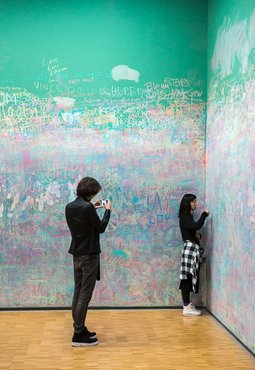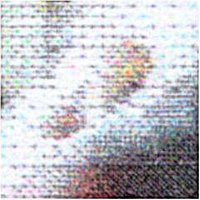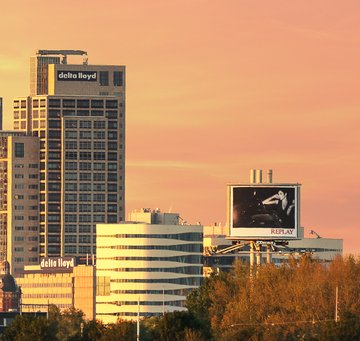Image Resolution part 3: How many megapixels do you really need?
An interesting question
In the previous article about resolution, I explained that printers have a native resolution. For optimal results, one should choose this native resolution.
In the current article, I will put this statement into perspective. Is it really always necessary to print at 300 PPI or whatever the printer desires? What about printing at poster size, how many pixels do we need then?
Turns out: it’s not so strict. Ever looked closely at a billboard poster? How about its resolution? Not very crisp, eh? So what about the 300 PPI rule, didn’t they follow that and if so, why not?
Apart from the fact that not many photos have enough pixels to fill a billboard in full 300 PPI resolution, there is a simpler answer to that question: one is not supposed to view a billboard poster from very close distance. A big image, whether a photo print, a painting, a canvas or whatever, is usually (and best) viewed from a certain distance. The bigger the image, the more a viewer tends to stand back. And guess what… the further away you are, the less pixels per inch your eye can resolve.
Photo exhibition: the public finds the best viewing distance
Centre Pompidou, Paris
All this leads to an interesting question: given a print size, what is the optimal viewing distance, what does that mean for the required resolution, and can we calculate the amount of pixels needed from that?
Some mathematics
The answer is yes, we can. Many websites give some sort of formula for this, plus a rough explanation. This involves quite a bit of mathematics that I don’t want to repeat here, but the good news is that the derived formula is not difficult at all.
I will start with a simple 10x15 cm (4x6 inch) print. (NB Since PPI seems to be the standard for print resolution, and all formulas start with an image size in inches, I will stick to inches here.)
First, we need to know the optimal viewing distance for such a print. General consensus seems to be that this is about 1.5 - 2 times the diagonal of the print size. Let’s be conservative and pick 1.5. The diagonal of a 4x6” print measures about 7.2 inch. The optimal viewing distance would thus be around 1.5 * 7.2 which roughly equates to 11 inch.
Second, we need to know the eye resolution at that distance. This can be derived from a human’s visual acuity which is defined as an angle, usually established to one arcminute (1/60 of a degree). Starting from that, the formula for PPI is the following:
PPI = 3,438 / viewing distance in inch
The suggested precision of the figure 3,438 should be taken with an enormous grain of salt. All sorts of factors affect the outcome, of which light conditions and the viewer’s vision are most important. Yet, we need something, and various sites seem to agree on this number, so let’s move on.
In our example the resulting PPI value is 3,438 / 11 = 313.
The rest of the computation - third - is straightforward. For a 4x6 inch print in 313 PPI we need 1252 x 1878 pixels. That’s slightly less than 2.5 megapixels.
I assume this won’t surprise many people. One needs 2.5 MP for a 4x6 print of sufficient resolution, provided of course that the source image is sharp enough and not overly compressed. So far, so good.
Fragment of an inkjet print. Copied from https://en.wikipedia.org/wiki/Dots_per_inch
Now let’s repeat the computation for a larger print, say 8x12 inch (20x30 cm).
- Diagonal 14.4”
- Optimal viewing distance 22”
- PPI 156
Believe it or not, that comes down to 1250 by 1872 pixels.
Looks familiar? Yep. These pixel dimensions are the same as those that we computed for the postcard print, bar a small rounding difference. For an 8x12 inch print, only 2.5MP is required for sufficient resolution - provided again that it is viewed from a distance that can be considered normal for this print size.
This highly surprised me. Make a print twice as large, the optimal viewing distance gets twice as large, the required print resolution gets halved, resulting in exactly the same minimal pixel dimensions.
Need another example?
- Print size 24x36 inch (60x90 cm)
- Diagonal 43”
- Optimal viewing distance 65”
- PPI 53
- Ergo: 1272 x 1908 pixels
Again, the difference with the previous results is caused by rounding.
A simple conclusion
The conclusion can’t be more clear. No matter the size of your print, 2.5MP is enough to make it look good at the appropriate distance. Sure, put your nose to a low-resolution big print and you will see that it’s not crisp. That’s similar to walking up to a billboard and seeing individual pixels. The reality is: the bigger the print, the further away one normally looks at it. Taking that into account, exactly the same amount of pixels are needed no matter how big the print.
A billboard seen from big enough distance
I hope this conclusion puts the megapixel race into the right perspective. Why do cameras get more and more pixels? Books, websites, advertisements, camera sellers and whoever may tell you “more pixels is better” but with today’s sensors it’s certainly not true. More is slower, more wastes disk space, and last but not least, more helps nothing if your lens is not sharp enough to outresolve all those pixels.
Gerald Bakker, 29 May 2016
Related articles
Photoshop by the Numbers






